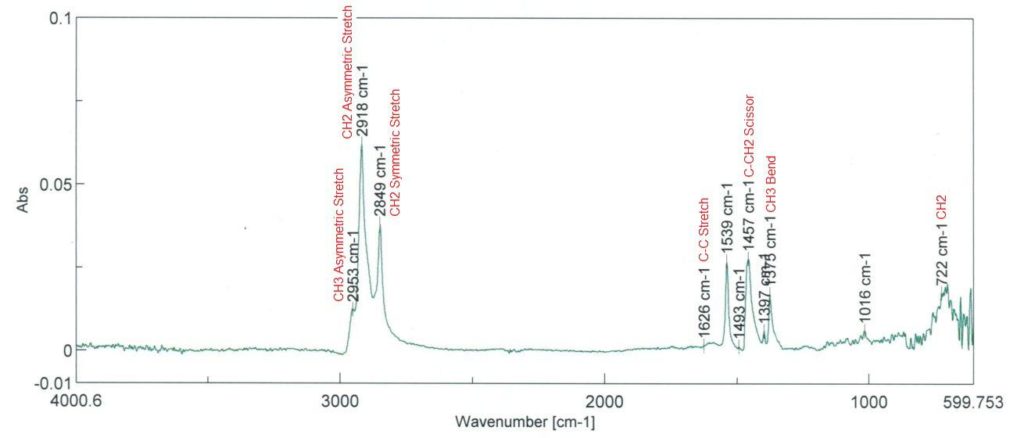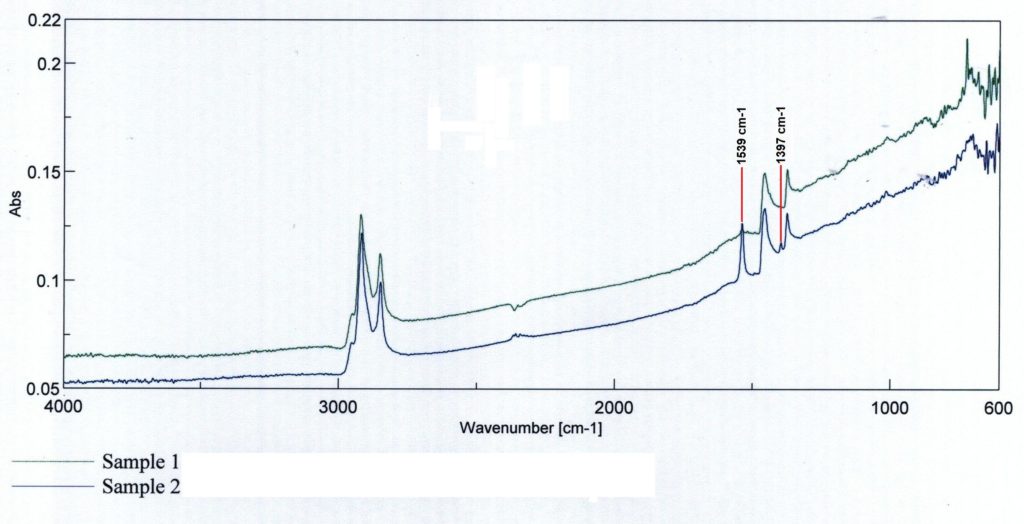Compound Identification in Quality Control
Are you getting the correct compound?
Written by Dale T. McGrosky
One of the most important, yet least frequently checked, quality control procedures is to verify the type of compound on your parts. You may receive certification stating that these parts are indeed the specific compound you requested, but what test was performed to back up the certification and who was the last to verify the compound and what method was used?
We have come across several methods of identifying rubber materials like measuring specific gravity, burn testing, Infrared spectroscopy, chemical analysis, the list goes on. Identifying materials with methods such as measuring specific gravity or burn testing will help you identify the type of material but these methods will not identify a specific compound. Chemical analysis, although very conclusive is very expensive and time consuming making it impracticable for everyday use. When it comes to a safe, quick, accurate, and conclusive method of material and compound identification that can be used safely everyday, our choice was the Fourier Transform Infrared Spectrometer (FT/IR). With the FT/IR we are able to identify materials easily and quickly and use this in our everyday quality inspection assuring our customers are getting the exact compound they ordered.
Specific Gravity (Density)
Lets go over some definitions first. Density is the mass of an object per unit of measure. For instance aluminum has a density of 2.8 g/cm3. The formula for density is Density (p) = Mass (g) / Volume (cm3). Specific gravity is a dimensionless unit that is defined as the ratio of density to the density of water at a specific temperature. Water at 4°C (39°F) has a density of 1.000 g/cm3.
Even though lbs/in3 (pounds per cubic inch) is often used, it is not the correct imperial (U.S.) unit of measure for density since pounds is defined as a measure of force. The correct imperial (U.S.) unit of measure for mass is the slug; therefore, the correct unit of measure for density is slugs/in3.
1 pound = .03108095 slugs.
Specific gravity is a good method of identifying a type of material or checking the accuracy of a compound. Each material has a different specific gravity and this can be useful in identifying a type of material. If you have a specific compound and know the specific gravity of that compound you can compare the specific gravity of the parts from that compound against the specified specific gravity to verify the accuracy of that compound. The acceptable tolerance for specific gravity in rubber compounds is ±0.02 (remember, specific gravity has no unit of measure). Although this method is good in identifying types of materials or checking the accuracy of a specific compound, in some cases it is not conclusive enough and further testing may be required to properly identify a material. One example is EPDM vs. Nitrile material identification.
EPDM and Nitrile have very close specific gravities. Most Nitrile compounds have a specific gravity around 1.23±0.02 and EPDM can come in around 1.20±0.02. Depending on the scale resolution, the sample size and operator accuracy, getting a conclusive identification between these two materials by specific gravity alone may not be possible and other methods such as a soak test may have to be used to assist in the identification process.
Specific gravity is a good method to identify the basic material such as Nitrile, EPDM, Silicone, Fluorocarbon, etc. but it may not be conclusive enough to determine the difference between two specific compounds such as a standard EPDM and an EPDM FDA Grade.
Burn Testing (Burning rubber is NOT recommended because some compounds can form highly toxic fumes.)
Another early method was to burn test the material and observe the ash, smell and burn characteristics of the material. Nitrile has a very distinct smell and if done in the office most of your colleagues will be quite upset with the lingering smell that has permeated their nostrils. Silicone, when burned has a white ash, Fluorocarbon won’t support combustion, when Chloroprene (Neoprene®) is burned in the presence of hot copper it will cause the flame to glow green (Beilstein Test). The list goes on depending on the type of material.
It is NOT a good idea to inhale the fumes from burning rubber. When you find it necessary to burn test rubber such as the Beilstein Test, this should be done in a well ventilated area and every precaution should be taken so the fumes are NOT inhaled.
Infrared Spectroscopy
The FT/IR is a device that shoots infrared radiation (energy), into a sample and measures the amount of IR radiation that is absorbed and transmitted by the chemical bonds between atoms in a molecule. The information is collected and a unique molecular fingerprint of the sample is created. Illustration 3 shows a graph of an EPDM compound. The graph shows the amount of energy absorbed at a specific wavenumber (cm-1). Different chemical bonds in the molecule will produce different peaks in the wavenumber range. The height of the peak shows the amount of energy absorbed at that wavenumber. The more of that type of molecular bond in the molecule, the more energy that will be absorbed creating a higher peak. With this information we can identify materials, types of molecular structures in the material and creates a unique fingerprint for each compound.
In order to understand the FT/IR scan, lets look at the chemical structure of and EPDM molecule as shown in illustration 2 and compare it to the FT/IR scan of an EPDM compound in illustration 3. But, before we get started lets take a look at how molecules vibrate.

Figure Caption “Illustration 1: Vibrational modes of molecules”
Molecules vibrate by bending or stretching. They stretch symmetrically or asymmetrically. They bend “In Plane” by rocking or scissoring and “Out of Plane” by wagging or twisting. You can see this in illustration 1. Each one of these vibrations will absorb energy at a particular wavenumber depending on the two atoms that are bonded.
In the chemical structure of EPDM, illustration 2, you can see methylene, CH2; Methyl, CH3; carbon-hydrogen bonds, CH; carbon-carbon bonds, C-C; and carbon-carbon double bonds C=C. Now take a look at illustration 3 and you can see where I identified the corresponding peaks. For instance you can see the CH2 Asymmetrical stretch at 2918 cm-1 and the CH2 Symmetrical Stretch at 2849 cm-1 and the CH2 Rocking at 722 cm-1. When we are identifying a compound with Acrylonitrile such as ABS, Nitrile (Buna), we look for the carbon-nitrogen triple bond, C≡N, peak between 2260 cm-1 and 2240 cm-1.

Figure Caption “Illustration 2: Chemical structure of an EPDM molecule”

Figure Caption “Illustration 3: FT/IR scan of an EPDM compound
To identify unknown substances, we do this in reverse, you can take a scan of an unknown molecule and identify the peaks and assemble the basic molecular structure. Another method is to compare the scan against a library of known scans to help identify the unknown compound. There are several websites that offer access to libraries of known substances for a fee.

Illustration 1: The graph above was produced by FT/IR scans on two EPDM compounds. We can tell by the graph that they are both EPDM material but they are not the same compound as shown by the two peaks present at wavenumber 1539 cm-1 and 1397 cm-1 in Sample 2 that are not in sample 1.
We used the FT/IR to help resolve an issue for a company that had a problem. They sell an NSF Certified product that contains EPDM O-rings. Since they purchase NSF Certified O-rings from 2 different suppliers, this company wanted to check if the failed O-rings were from vendor 1 or vendor 2. We received several o-ring samples identified as “Failed O-rings” — Sample 1, and O-ring samples taken from the same batch that were sent to the customer – Sample 2. Our objective was to determine if Sample 1 was the same compound as Sample 2. As shown in illustration 4, the two scans are similar and we were able to determine that these samples were EPDM material but the two peaks at wavenumber 1539 cm-1 and 1397 cm-1 in Sample 2 are not in Sample 1 indicates that these compounds are different. Our conclusion was these samples were both EPDM but they were not the same compound.
We looked at several methods of identifying compounds. Specific Gravity and burn testing will help identify the material but does not help much in identifying a specific compound. Chemical analysis is accurate and conclusive but is slow and costly. Our preference at Satori Seal for a quick method of compound identification for use in our quality control inspection is the FT/IR. With the FT/IR we identify and match compounds, we fingerprint our compounds allowing us to quickly scan actual parts and get a conclusive identification assuring our customers that they are getting the compound they ordered.

